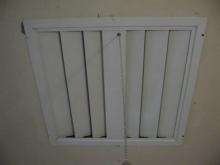Whole-house fan

A whole-house fan is a type of fan, or exhaust system commonly venting into a building's attic, designed to circulate air in a home or building.[1] It is sometimes confused with a powered attic ventilator, which exhausts hot air from the attic to the outside through an opening in the roof or gable at a low velocity.[2]
Description
A whole-house fan pulls air out of a building and forces it into the attic space. This causes a positive pressure differential in the attic forcing air out through the gable and/or soffit vents, while at the same time producing a negative pressure differential inside the living areas which draws air in through open windows.
Powered attic ventilators, by comparison, only serve to remove some hot air from the attic. Intake air comes directly from outside, instead of from the house interior. Attic ventilators are used when air intake from the house is not desirable, such as when the interior is air-conditioned. Typical diameter is 24 inches (61 cm), having motors of power 1⁄4 to 1⁄2 horsepower (0.19 to 0.37 kW), and using 120 to 600 watts of electric power.
History
Before the development of electrical power the principle of cooling a building by designing it to draw in cooler air from below and vent it from the top was known. In the absence of the forced air movement produced by a fan, careful design to promote cooling air flow was required. Thomas Jefferson, US president from 1801 to 1809, was personally involved in the designs of his residences at Monticello and Poplar Forest, and was aware of these techniques. Monticello had a large central hall and aligned windows designed to allow a cooling air-current to pass through the house, with an octagonal cupola at the top of the house drawing hot air up and out through natural convection.[3]
Whole-house fans were popular in the 1950s and 1960s, mainly in the Southern United States, as they were much cheaper and easier to find than air conditioners and still removed hot and stale air relatively well.
Types
There are two types of fan:
- Ceiling Mounted: Mounted on ceiling between the attic and living space.
- Ducted: Remotely mounted away from the ceiling; can exhaust heat from multiple locations; operation is extremely quiet.
Gallery
-
Fan unit before installation
-
Louvers open while fan is operating
See also
References
- ↑ Whole House Fan Defined, "http://www.homewyse.com/definitions/whole_house_fan.html"
- ↑ Attic Ventilator Defined, "http://encyclopedia2.thefreedictionary.com/attic+ventilator"
- ↑ MARYLOU TOUSIGNANT (17 May 1998). "Cooling Trend Predicted for Mount Vernon". LA Times. Retrieved 7 August 2016.